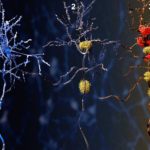This team is directed jointly by Saaid Safieddine (DR2 CNRS) and Yann Nguyen (PU-PH, Sorbonne University). Saaid Safieddine is an expert in the molecular physiology of hearing, and the synapse in particular, and is a pioneer in gene therapy for deafness. Yann Nguyen has extensive experience in the development of innovative techniques for minimally invasive robot surgery on the auditory sensory organ. The objective of the team is to develop effective gene therapy for hearing problems via the optimization of therapeutic vectors and their delivery systems.
Axes of research
Thanks to the advances in human genomics achieved over the last 20 years, important progress has been made towards understanding the pathogenesis of diverse forms of congenital and acquired deafness. The identification of deafness genes, the potential targets of treatment, and the generation and functional characterization of mouse models of human deafness have increased our knowledge of the molecular physiology of auditory sensory cells. This has paved the way for the development of new therapeutic strategies. Over the last 10 years, the efforts of our group have focused on the development of gene therapy for inner ear abnormalities. The objective is to accelerate the valorization of the many discoveries or our laboratory over the last 20 years, in the form of concrete applications of benefit to affected patients. The research performed by our team is, thus, principally translational, and largely dedicated to the development of safe and effective gene therapy for hereditary or acquired deafness, delivered by a robotic system.
We are fully aware of the challenges posed by such an objective, and have thus built a multidisciplinary team, a source of mutual enrichment, composed of students, engineers, researchers, and ENT surgeons. The two principal axes of research are:
I. Gene therapy
(Group leader: S. Safieddine)
The aim of this work is to generate recombinant therapeutic viral vectors to target various genetic forms of deafness, and to evaluate their efficacy, specificity and innocuity.
Viral gene therapy for deafness
We are currently working on an inner ear gene therapy project, in conditions allowing the first European clinical trial for patients with DFNB9 deafness, and we are continuing to work towards identifying new vectors for the effective and specific targeting of different types of inner ear cell. This project has six objectives:
1. Study of the tropism of the AAV capsid in the non-human primate cochlea
A prerequisite for the application, in patients, of results obtained in the mouse model of DFNB9 is the demonstration that the dual-AAV approach is effective in non-human primates. To this end, our team will study the cellular tropism of the AAV2 capsid in macaque cochlea, using GFP as a reporter gene. This will make it possible to optimize the surgical approach and to evaluate, by immunolabeling, the cellular distribution of GFP in the cochlear sensory epithelium of the macaque following viral infection.
2. Design of an optimal human otoferlin promoter for optimal spatiotemporal expression exclusively in the inner hair cells
The 5’ flanking region of the otoferlin gene has been analyzed in silico to identify the regulatory elements controlling the expression of the human OTOF gene. The genomic sequence upstream from the transcription initiation site (5 kb) has been analyzed to identify sequences conserved during evolution, and these highly conserved sequences have been used to identify key regulatory elements involved in the control of otoferlin expression.
3. Evaluation and optimization of the activity of the human otoferlin promoter
The team is currently evaluating candidate sequences identified as described above, both in cell culture, and in vivo. The nucleotide sequence encoding GFP has been inserted into the AAV2 viral genome downstream from the two selected candidate sequences, and packaged in the AAV8 capsid. The infectiousness of the viral preparations was first checked in vitro in HEK cells, and in vivo in mice. The viral preparations will be injected through the round window membrane in macaques. The cochlear sensory epithelium of the macaques receiving these injections will be immunostained to assess GFP expression after viral administration.
4. Design and evaluation of a recombinant therapeutic vector for preclinical trials
We will use the most specific and most effective promoter/capsid configuration. Given that the otoferlin cDNA (6 kb) exceeds the packaging capacity of AAVs (5 kb maximum), a strategy based on two AAV vectors will be adopted.
5. Generation of specific viruses to target different types of inner ear cell
The function of the inner ear involves the coordinated action of the sensory hair cells, the support cells, the auditory neurons and the stria vascularis. Genetic defects of one of these cell types can lead to inner ear deficits. Mutations of the gene encoding otoferlin cause DFNB9 deafness, through effects exclusively in inner hair cells. Conversely, stereocilin mutations affect only the outer hair cells and result in DFNB16, a progressive form of deafness. Mutations of the gene encoding connexin-26, which cause the commonest form of deafness, DFNB1, affect the support cells and the stria vascularis, two actors essential for the potassium homeostasis of the cochlea. Moreover, DFNB1 is also associated with severe balance defects. For each of these forms of deafness, targeting the type of cell affected without causing secondary effects will require the use of recombinant AAV vectors with specifically optimized tropisms, and regulatory elements controlling the expression of the therapeutic gene. The achievement of specific expression of the therapeutic gene within a particular type of inner ear cell will be a determinant step towards clinical applications. We have implemented an approach based on directed evolution in vivo, previously used in the retina (Dalkara et al., 2013), to generate AAVs to improve the transduction of inner ear cells over what is possible with the AAVs currently available, which have a limited transduction efficiency.
II RobOtol: robotic assistance for otological surgery
(Group Leaders: Y. Nguyen; S. Mazalaigue)
The RobOtol system has entered clinical trials, and more than 50 patients have already undergone surgery with this system since 2018. The aim of this work is to optimize the operating time for the robot-assisted surgical procedure on the middle and inner ear, making it possible to simplify surgical gestures, to increase safety and to decrease the intervention time.
1. Optimization of the RobOtol system
New innovative, multifunctional and intelligent instruments will need to integrate into the environment of the operating theater, and respect its constraints. Our system aims to provide broader assistance to surgeons, by integrating peroperative imaging and navigation tools. Our work will fuse these two systems, robot and navigator, thereby defining the ontological operating theater of the future. The surgeons of tomorrow will have access to a large amount of information (peroperative imaging, navigation, real-time electrophysiological data, etc.) that they will need to take into account to ensure that surgery is both safe and effective. The centralization and coordination of data, and the grouping together of all this information within a single visual zone, are key areas requiring additional work (e.g. 3D or 4k screen, retinal projection or projection on glasses).
Perspectives and potential repercussions
Given the innovative nature of this work and our leadership in the field of automation in middle ear surgery, there are important perspectives in terms of publications, patent depositions and patient recruitment. About 30,000 patients per year undergo middle ear surgery in France. The percentage of results considered “good” ranges from 50% for total reconstructions of the bone chain to 90% for otosclerosis surgery. The improvements in surgical technique provided by tools such as RobOtol should decrease the surgical risk and improve functional results.
2. Robotized vectorization of inner ear gene therapies
The administration of treatments validated in cell culture models has, to date, been limited by the blood-perilymph barrier and the destructive nature of the techniques currently available for accessing the organ of hearing. The key objective will be to develop means of reaching the hearing organ in a controlled and systematically non-traumatic manner. This work will take place in two steps: the first step will be the automation of cochlear implant fitting, and the second will be the development of systems for administering gene therapies to the inner ear.
2.1. Development of a robot-assisted system for fitting cochlear implants
(Team Leaders: Y.Nguyen, I.Mosnier)
Our team performed the first robot-assisted insertion of a cochlear implant in July 2019, in collaboration with the ENT department of Pitié-Salpêtrière Hospital, the reference center for cochlear implants in adults in the Ile-de-France region. About 220 auditory implants per year are fitted at this reference center.
The short-term objective is a convergence of research projects with the RobOtol system, to couple this system to a navigation system, to guide access to the cochlea and control access for insertion. In the medium term, the goal is to endow the robot with additional sensors, such as systems for the real-time measurement of hearing during the intervention, making it possible to conserve the residual hearing of the patients undergoing implantation.
Funding and projects complementary to those covered by the Fondation pour l’audition grant
ANR active cochlear implant project “Robocop” 2020-2024
The “Linearly activated electroactive polymer inspired by human muscle for the controlled and non-traumatic insertion of cochlear implants” project aims to modify current electrode array technology to allow active control over the positioning of these arrays in the cochlea. This project aims to use materials mimicking human muscle to guide the trajectory of cochlear implant insertion into the cochlea in real time. This will make it possible to control the dynamic system via the use of a closed-loop command and to deform the implant during its progression, to refine its trajectory and avoid structures at risk, such as the basilar membrane.
2.2. Development of a system for the administration of gene therapies to the inner ear
(Team Leader: E.Ferrary, project performed in collaboration with the team of Saaid Safieddine, including G.Lahlou in particular)
The aim of this project is to combine the knowledge and know-how of the team of Saaid Safieddine and our own. The treatment of deafness of genetic origin will be possible only if a complete administration system can be developed, composed of vectors constructed specifically for gene expression in a target cell type with a minimally invasive robot-assisted surgical approach preserving the support structures and the sensory and nerve cells that are still functional. The ultimate goal is to allow the management of patients with genetic deafness, to improve on the rehabilitation results currently achieved (hearing aids, cochlear implants) and, one day, to be able to repair the hearing organs of patients bearing mutations of genes identified as involved in hearing (e.g. otoferlin).
Perspectives and potential repercussions
If the objective of developing systems for the non-traumatic delivery of drugs to the inner ear is achieved, a new way of reaching the inner ear will be obtained. This will pave the way for a large range of clinical trials in the medium term, assessing gene therapies developed at the Hearing Institute, but it will also serve as a booster for the transfer into clinical practice of all the innovative inner ear treatments developed at the Hearing Institute or by its international partners. This transfer will be facilitated by close collaboration with the ENT specialists of the Pitié-Salpêtrière and Necker University Hospitals, at the heart of adult and pediatric CERCAs (centers for the study of cognition and learning).


